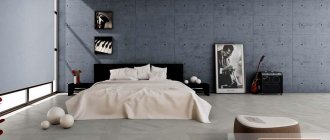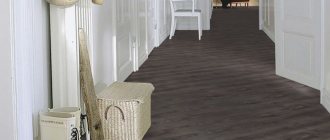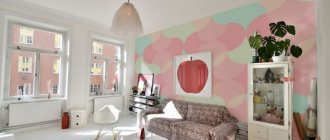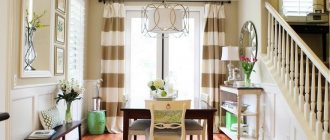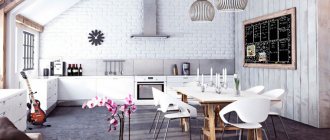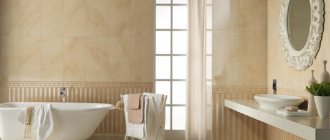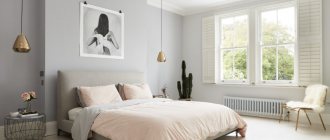What influences the choice of color in the hallway
The corridor is a place for light colors, unless otherwise provided by the overall design or original design. Due to the lack of windows (which is typical for almost all hallways) and compact size, it is customary to brighten corridors with the help of walls and rich artificial lighting. Searching for objects in a dark room is not very pleasant, so some people simply leave the light on all day long. If everything is clear with the ceiling - it should be light, then the color scheme of the walls depends on the lighting, textures, the presence of textured surfaces, and the need for combining shades. Size, of course, has its influence. In narrow spaces, light cannot spread well due to the darkness created by the walls. Pieces of furniture will cast shadows. So all these nuances should be considered along with the definition of the pros and cons of light or dark design.
Previous design experience is not always objective, because materials are constantly being improved, but it will definitely help you decide whether to use a particular color.
Hallway size
The shape of the entrance space tends either to be rectangular, as in two- and three-room apartments in Brezhnevka apartments, or it is square, as in most Khrushchev-era apartments. The optimal minimum width is 1.4 meters, and length - from 2.5. In such a corridor you can install modular systems and open storage. Hallways that are already 1 meter wide are almost always expanded, all that is needed is technical capability. Building codes provide for a width of 1.2 meters for places where the hallway opens into other rooms, and sections that are already a meter long are no more than one and a half meters long. All hallways consist of 2 parts - a reception area and an area for arranging communications. It wouldn’t hurt to find a place for a sofa, and in the spacious corridor of a multi-room apartment - for a large guest area similar to the hall. In locks with a height reduction of up to 2 meters, mezzanines are made.
Combination of materials
The hallway is decorated with one material or nice combinations. The first of these should be noted is the combination of wall panels and wallpaper. The walls of the loft hallway are decorated with whitewash and textured coverings, and sometimes bare walls with remnants of torn wallpaper are added to this ensemble. The technique of abruptly interrupting the brickwork has become traditional. In the classic version, elegant combinations are created with wallpaper, plaster, tiles and stone surfaces. Interiors in a modern style are made with the combined use of glossy, matte and satin finishes. The walls combine materials with a pleasant texture. Wood is combined with plastic and mirror polystyrene. Bamboo panels can be seen next to stone surfaces. The hallways are also finished with different types of wood coverings. Heterogeneous finishes, among other things, are used for zoning.
Texture and print of finishing
Some types of textures:
- Flat;
- Rough;
- Patterned;
- Geometric.
The corridor is usually left without a pattern if it is finished with panels. Oblong and compact planks are smooth and faceted in texture. Patterns usually cover glossy surfaces. Drawings and prints “get” into the corridors on regular and photo wallpapers, 3D compositions, panel films and painted walls. Fans of texture and color variety on surfaces should take a closer look at plastic. Imitations are made from the material, copying any raw material and repeating any colors. At first glance, natural wood, metal and stone cannot be distinguished from their plastic counterparts. Natural and synthetic materials are often painted white, creating solid monotonous surfaces. All those who like to personally participate in the design of their home should pay attention to paintable wallpaper.
Hallway illumination
A lack of light means a dull and unclear environment. Therefore, the corridor is either illuminated with several modern lamp options or with huge chandeliers. The main and additional devices of the modern type are mounted mainly on the ceiling, but extended versions such as linear ones are also installed on the walls. Wall sconces, which have recently appeared in any form, are also hung there. Products in a modern style look like boxes. They are assembled into compositions, directing light in different directions and using square and elongated devices. Grilyato ceiling systems have proven to be effective. Then a few spotlights on the walls are enough. Horizontal surfaces provide the best location for bendable strip lights with LED sources. In turn, the natural flow of light is organized through transparent doors or the absence of curtains in the interior passages.
What paints should I use?
To use paint and varnish material in a hallway or corridor, it is necessary to pay attention to the basic qualities and characteristics of the paint, since this will ensure long-term operation of the coatings, protect the walls from mechanical loads, the influence of liquids and other contaminants characteristic of this room.
Features of corridors and hallways:
- Location near the front door, which implies frequent sudden changes in microclimate and temperature, drafts. This destroys the coating with insufficient elasticity.
- Outerwear, shoes, umbrellas, and hats are often removed and left in the hallway or corridor. In bad weather, these things are often wet and dirty, which, as a result of moisture coming into contact with the walls, will directly put a load on the surface of the walls located close to the hangers. Paint and varnish coatings must have good wear resistance.
- Through the corridor and hallway, all objects enter the apartment: furniture, other large items. It is rarely possible to apply them without damaging the walls as a result of impact or friction, so the paint must form a durable film.
- Due to the openness of corridors and hallways to other rooms and spaces in the apartment, owners have to come into contact with evaporation from the walls, which should not be toxic or harmful. Intermediate spaces should be painted with paints intended for use in residential buildings.
The best paints for decorating walls in hallways and corridors are water-dispersed paint compositions. They have all the necessary properties and are vapor permeable. Let's consider the types of this category of material.
Acrylic
High-quality but expensive paints and varnishes for interior decoration. They are resistant to direct exposure to UV radiation, vapor and moisture permeability, and film strength.
Due to its high drying speed and color retention, regardless of the operating conditions of the room, the paint forms a soft, even coating that can hide even small cracks as a result of painting.
Butadiene styrene
Budget materials that are suitable only for interior work in rooms exposed to moisture, liquids, and other contaminants on the walls. It is necessary to take into account that the paints of this series are not resistant to sunlight.
As a result of prolonged contact with UV radiation, surfaces painted with water-based butadiene styrene paints acquire a pronounced yellow tint.
Polyvinyl acetate
These paint and varnish compositions are cheap, with the most modest moisture resistance indicators. They should be used in rooms where contact with moisture is minimized.
Alkyd enamel
The peculiarity of the coloring composition is the presence of toxins of organic origin. When painting a room, a persistent, very unpleasant characteristic odor is created. To eliminate this effect, you need to intensively ventilate the treated rooms for at least 3-5 days.
You can find odorless alkyd enamels at a higher price due to the composition with polyurethane-based additives.
Photo of dark corridors in the apartment
A dark palette allows you to set a certain shape and mood for the room, as well as impart nobility and sophistication to the interior.
Finishing materials in dark colors will provide an excellent background for furniture items. Such a rich color scheme does not create dissonance in the room and highlights every item and accessory in the room, giving them a clearer look.
Dark walls become an advantageous addition to a corridor in fusion, art deco or other eclectic styles, characterized by bright contrasts and a combination of incongruous elements.
The photo shows a large hallway in dark shades in the interior of the apartment.
It is believed that black shades make the atmosphere gloomy and visually make the room smaller, so such colors would be extremely inappropriate for decorating a small hallway. However, a spacious corridor in black, in combination with well-chosen furniture and proper lighting, will look very fashionable, expensive and elegant.
Dark tones have invaluable beauty, are distinguished by originality and aesthetics. In the design of the corridor, it is important to use deep cobalt, dark blue, complex purple colors or mysterious shades of indigo, which give the enclosed space a certain depth.
An expressive burgundy color scheme will add special aesthetics and sophistication to the decor.
Hallways in light colors
One of the main advantages of a light color scheme is its ability to visually expand spatial boundaries and make the room brighter and more comfortable.
This palette goes well with all shades. Against the background of a light wall covering, various decor and accent details look more advantageous.
The photo shows the design of a hallway with light walls covered with peach-colored paint.
Pastel colors fill the room with calm, cleanliness and freshness. An entrance hall in soft blue, lilac, pale green or ivory tones always has a well-groomed and pleasant appearance, and also has a warm and homely atmosphere.
Painting the walls a neutral beige or light gray will make a small space feel much larger and larger.
The photo shows the blue and white decoration of a small corridor in the apartment.
Brown corridor
Chocolate color combined with wood texture will create a respectable corridor design. Brown is considered a classic choice for people with conservative tastes.
The most popular color solutions include coffee colors, shades of cocoa or cinnamon, which have extraordinary softness and warmth.
The photo shows brown colors in the design of a spacious corridor.
Hallway in gray tones
The corridor in gray has a rich range that harmoniously combines with other tones. Thanks to such combinations, the interior will never be oppressive and faceless.
Gray is quite practical. Metallic, graphite, pearl colors or a shade of wet asphalt have a positive effect on the environment, promote relaxation and relieve tension.
For decoration, it is better to use a lighter ash and smoky palette. Such a hallway in gray always looks airy, fresh and spacious.
The photo shows the interior of a modern hallway in gray tones.
Hallway in white
Snow-white colors fill the corridor space with cleanliness, volume, comfort and give dark furniture or decor additional brightness and attractiveness.
Just as outerwear and sometimes dirty or wet shoes are removed in the corridor, the white design will quickly lose its impeccable appearance. Therefore, ivory shades are suitable as an alternative option. They look rich, harmonize well with other colors and add presentability to the interior.
The photo shows the design of a corridor made in white.
Mint color in the hallway interior
If you choose the right companion colors for the delicate mint color scheme, you will be able to create a fairly harmonious color composition that will match the dimensions and decor of the room.
The mint palette is effectively combined with white, grey, blue or gold tones. For modern design, a combination with red would be appropriate.
Hallway in beige tones
The most comfortable and warm color that fits perfectly into the corridor space and creates a pleasant atmosphere in the room.
Beige walls will go well with floor or ceiling cladding in restrained and natural brown, white or gray tones.
The photo shows a corridor in beige shades with splashes of white.
Turquoise color hallway
The turquoise interior is original and catchy. The natural shade of turquoise, combining heavenly radiance and sea waves, gives the atmosphere an attractive charm and freshness. This color gives the hallway a discreet luxury, and thanks to different color duets it allows you to create an interesting visual effect in the room.
Hallway ideas in bright colors
The hallway in an apartment or house is a great place to create expressive touches and bold color experiments. Extraordinary color solutions due to a short stay in the hallway will only have a positive effect on the surrounding space and add special tone and effectiveness to it.
For example, bright red tones will not leave anyone indifferent and will undoubtedly attract attention, orange will create an optimistic, positive and bright atmosphere in the corridor, and pink will at the same time add richness, solidity and intimacy to the hallway.
Yellow, lemon or mustard colors have a charming warmth and, due to their good compatibility with other color palettes, provide the opportunity to realize original design ideas and ideas.
The photo shows the interior of the corridor, decorated in red.
Creating interior harmony
A small room will look impressive in brown if you choose the right shades. It is distinguished by its variability, which allows you to design almost any interior option. For a small, dimly lit hallway, it is best to use a light palette close to beige. In addition, it is important to combine the presented tone with another palette. A brown hallway will look great in combination with the following colors:
- White. This is a universal design option for a hallway or corridor, as it allows you to visually create a beautiful interior. White “mutes down” the richness of brown. This combination is perfect for classic furniture. If artificial and natural lighting in the hallway is poor, it is best if white is the dominant color;
- Pink. At first glance, a room in such an arrangement will look banal and unoriginal. But this is not true at all. Brown allows you to make pink less “sweet,” which has a positive effect on the appearance of a small room;
- Green. This tone, like the one presented, belongs to the natural palette, so their combination will be effective and attractive. Lush natural options will help create pleasant living conditions. Green has a lot of tones, so you can choose the right option just for you. If the room is very small, then give preference to light shades. It can be light green, olive or pale pistachio shade;
- Violet. This combination option must be designed very carefully, since the combination of cocoa and purple colors creates a mystical, gloomy design. For a small room, this effect is undesirable, since a small area with poor lighting will look ugly.
Light and color
The next factor influencing the main tone of the hallway is its illumination. The main thing here is to follow the rule: the brightness of the walls is directly proportional to the amount of light in the room.
If the hallway has a window facing the sunny side, or the lighting scenario is well thought out, then the choice can be made in favor of:
- blue;
- green;
- indigo;
- sea green;
- turquoise;
- purple.
A dimly lit hallway should be decorated in light colors.
What designers do not advise doing is choosing white, since in low light it becomes dull and, over time, also “dirty.” White is a “reflector” of daylight, and when there is nothing to reflect in your hallway, it is better to give preference to another shade.
Options for color combinations in the hallway
When choosing a color palette for the hallway, you need to focus on the “rule of three colors.” Having decided which color will play the main role, you can decide which ones will complement it. If you plan to paint the corridor in neutral colors and without sharp accents, then it is better to choose shades that are similar in palette - soft transitions will not begin to irritate over time. For example, a combination of milky and beige, brown and gray, turquoise and blue.
And when you want contrast, white will be an excellent match for any color. The combination of rich shades of walls, white furniture and doors looks impressive. In this case, the ceiling and flooring should be made neutral.
In the case of bright furniture, the best solution would be to paint the walls in light shades, for example light gray, which goes well with orange or bright green.
In order to place bright accents, modern lamps, a spectacular hanger for outerwear, a mirror in an interesting frame or beautiful paintings will come in handy.
How to combine colors in the hallway
When decorating any room, you need to be guided by the “three-color rule.” This means that you need to decide which color will become the main color and which two will be additional.
If the hallway is designed in a neutral color and without bright accents, then you can choose combinations of colors similar in palette, for example: milky and beige, brown and gray, turquoise and blue. Soft transitions from one color to another will not irritate or bother you.
In cases where contrast is required, white will be an excellent match for any of the bright colors. The combination of walls in rich, rich colors and white furniture and doors looks very impressive. In such cases, it is better to make the ceiling and floor neutral: for example, bright yellow walls will harmoniously combine with a grayish ceiling and light gray-brown flooring. If the furniture is bright, then the best background for it will be light walls - for example, in a light gray hallway you can “settle” a cheerful green wardrobe or an orange pouf.
Accessories in black, dark brown or dark gray will help create contrast in the interior. They can be unusual modern lamps, an original hanger for outerwear, as well as framing pictures or mirrors.
Fashionable design solutions in 2021 (photo selection)
Let's look at the fashion trends in hallway design for this year:
- When creating the interior of a hallway, it is important to plan the arrangement of furniture. Since there are few free walls left, finishing plays a secondary role.
- Repair is made difficult by a large number of items. Be smart and embrace minimalism.
- Use no more than three colors for finishing: wood, white, gray or dark. Everything in the hallway has its own colors, for example, a wood floor, a snow-white ceiling, a dark rug. These colors are present in almost every interior. If you bring in bright colors, it will look pretentious and ridiculous.
- The hallway with built-in furniture and hidden LED lighting matches the fashionable design.
If the hallway is designed in a neutral color and without bright accents, then you can choose combinations of colors that are similar in color palette.
When decorating a small corridor, the priority should be neatness and functionality. Make the background in neutral colors, and we recommend choosing decorative plaster for finishing materials. It is reliable, stains are not visible on it, and is easy to clean. If you wish, you can choose wallpaper for painting or painting. If you have a spacious hallway or are planning a redevelopment, then the design will be completely different. For finishing you can choose several materials.
Textured surfaces add variety to the interior of a gray hallway. The texture can be created using decorative plaster.
When designing a corridor, its functionality comes first, and its elegant appearance, comfort, and convenience come second. It is important to observe moderation in everything.
Textures and prints
Do not forget that the textures of finishing materials can also help achieve the desired visual effect. Nowadays, wall decoration with natural wood is gaining popularity, since it is not only an environmentally friendly material - it does not require perfectly aligned walls, and well-chosen shade and pattern of wooden panels will help expand the space of a small hallway, making it cozy and warm.
Decorative brick and plaster finishing does not lose its position, but it will look better in large hallways, where there is a need for zoning and you don’t have to be afraid that the finishing material will “steal” a certain amount of space.
It is also worth paying attention to the ombre effect, which will help make the hallway unique.
As for prints, when decorating a hallway they can both play a cruel joke and correct the shortcomings of the room. So, horizontal stripes will visually expand the space, and vertical ones will raise the ceiling a little higher (a white horizontal stripe on the wall along the ceiling has about the same effect). But it is better to avoid overly variegated or large patterns - they will visually make the hallway smaller and will most likely quickly begin to get on your nerves. More useful interior design tips →
Choosing the right wall color
In most cases, hallways are small. Basically, these are square or elongated rooms. The small area limits the choice, but there are criteria that should be taken into account:
- Area and layout of the premises. The smaller the hallway, the brighter the interior should be. A large corridor in a private house can be decorated in shades of dark colors, but for a small room it is worth choosing lighter shades.
- A stylistic direction that is used for interior design. Each style has characteristic features that you need to use to create a beautiful and stylish hallway.
- Features of the layout. In order to visually reduce a long corridor or increase the height of the ceilings, you should choose wallpaper with vertical stripes. To lengthen the room, a horizontal strip on the walls is suitable.
- Lighting affects the overall perception of the interior. Many corridors lack windows; the lack of natural light can be compensated for by placing artificial light sources. Good light will help highlight the color of the walls.
- It is not recommended to use more than 3 shades to decorate a hallway.
When choosing materials, it is worth considering the load on this functional area. Every day residents leave the house and return back. Depending on weather conditions, wet clothes, dirty shoes and wet umbrellas may appear in the hallway. Preference should be given to materials that are resistant to dirt and moisture. It would be appropriate to replace the snow-white shade of the walls with beige or cream.
Choosing a color for the corridor
The colors used are of great importance in creating a harmonious interior. The mood created when entering the apartment will depend on this. The selection of the palette depends on the following parameters:
- room size. Using dark tones is not always advisable. They are able to visually narrow the room, which will negatively affect a small hallway;
- style. It must be remembered that not every design allows for a free choice of colors. For example, acidic or bright colors in a classic style will be inappropriate;
- Decoration Materials. There is also a direct relationship here. When decorating a corridor with natural wood, the use of purple flowers is absolutely illogical. However, the color range expands significantly when finishing with panels.
These simple rules will help you choose the optimal combination of colors and create the necessary mood.
Dark colors
The practicality and beauty of dark shades in the hallway is invaluable: the room looks aesthetically pleasing, functional and original. Hidden lighting along the ceiling will help add an intriguing sense of mystery.
If you decide to use dark colors, you need to familiarize yourself with the features of their use in order to avoid a gloomy result:
- practicality - a corridor in blue or gray will make dirt appearing on the walls invisible;
- to avoid monotony and gloom, you should select a contrasting combination of shades;
- the framing of the walls is done in not too dark tones of gray or brown;
- When choosing a dark blue decor, you should not allow it to dominate.
The combination of colors in the interior of the corridor should be harmonious and discreet.
Light shades
Rooms that do not have natural light require a special approach to decoration, so many people choose light interior colors. This allows you to enlarge a small space, fill it with comfort and light. Among the advantages of light, almost white tones, it is worth highlighting:
- the lighter the finish, the less artificial lighting is required;
- light colors (for example, blue, turquoise) allow you to mask planning errors and uneven walls;
- excellent combination with all colors greatly simplifies the design;
- very light shades of olive and pistachio have a beneficial effect on the psyche and create special comfort.
Disadvantages include impracticality and rapid contamination.
Universal colors, their features
The hallway connects the apartment or house with the outside world. Only the necessary furniture intended for storing clothes is placed in a small area. You can decorate the room by decorating the walls and using a small number of decorative elements.
As the main color, you should choose universal shades that look harmonious in any interior; you can easily match them with bright decor. The main color should occupy about 70% of the entire interior, the number of bright spots should not exceed 30%.
Universal shades that are perfect for hallway design include:
- light yellow;
- beige;
- sand;
- terracotta;
- cream;
- peach;
- mint;
- grey;
- pearl gray;
- coffee with milk;
- lilac.
Gray tones combined with beige, many mirror surfaces, and white accents allow you to create a stylish interior. Gloss and many mirrors visually increase the space. Depending on what effect you want to achieve, you should decide what color to paint the corridor.
Shades of bright colors enliven the interior and give it a mood. Painted mustard walls highlight the neutral beige doors and brown wardrobe. Despite the lack of lighting, the hallway is warm and cozy.
The optimal solution for decorating a hallway is natural shades chosen for the base, and bright spots that dilute the boring design. The living space, the design of which is made in a single color scheme, looks stylish and complete.
The color difference allows you to harmonize the interior, which also gives the interior a sense of dynamics. For this purpose, various combined colors or several shades of the same color are suitable.
Hallway style in pink tones
The pink color of the hallway will be appropriate in a variety of interior styles.
.
For an eclectic room, the perfect combination of hot pink with silver and blue shades. An Art Nouveau style hallway will favor soft pink walls with a steel tint and shiny mirrors in silver frames. Pink color would be appropriate in wall decor, upholstery or accessories in a room designed in Provence style, as well as in an oriental, Asian or retro hallway. Oddly enough, even the strict Victorian style is receptive to pink. By skillfully combining it with burgundy, noble red and purple as the main tone of the walls, you will achieve amazing results
. A matching leather sofa in the Chesterfield style and a dark wood dressing room will help complement the interior. You can easily find accessories that suit your style in one of the promotions of the WESTWING shopping club.
Thus, the pink color in the interior of the hallway does not necessarily have to evoke associations with the room of a young princess or a Barbie doll. Get rid of stereotypes and feel free to experiment
! We, in turn, hope that our advice was useful to you.
Classic style - colors for walls
When you need to design an interior that will remain relevant for a long time, you should give preference to the classic style. This direction is characterized by rigor, elegance and functionality. Natural materials are ideal for finishing and decorating a room:
- Fine wood or stone tiles, such as marble, are suitable for the floor.
- They make stucco on the ceiling.
- It is better to choose plaster cornices.
- For walls, paint with a matte finish, wallpaper with ornaments, and decorative plaster are suitable.
Designers advise painting the walls in the corridor:
- white;
- gray;
- beige;
- olive;
- burgundy;
- brown;
- purple.
The classic style welcomes light and muted colors. Plain wallpaper, Venetian plaster, and paint are suitable for wall decoration. The hallway should be painted in a single color scheme; the material may contain a light pattern or design.
Carvings, columns and stucco will help complement the monochromatic design. Also, as decoration you can use natural materials, mirrors, luxurious wall lamps, which will be combined with the main lighting fixtures in the corridor.
In the presented version, the walls are painted with beige paint, and black and white tiles with squares were used to decorate the floor. Mirrored cabinet doors increase the space and, by reflecting the flow of light, create interesting shimmers. To decorate the hallway, we hung a luxurious chandelier and installed a decorative vase in the corner.
Light shades are better than others for decorating a hallway in a classic style. In combination with light furniture and decorative elements, the interior looks luxurious and majestic.
Shades of dark colors can be used for spacious hallways. It is important to provide good lighting that will highlight the chosen wall color or pattern.
The walls of a traditional classic hallway are predominantly light and warm. All details are harmoniously combined with each other; there are many unusual and beautiful decorative elements in the room. Neoclassicism is characterized by a wider range of colors. Contrasting colors and bright details can be used.
Color scheme and interior style
All decorative elements in the room must match each other. Therefore, the style of the room will depend on the choice of hallway color. Of course, now there are a large number of different interior solutions. But we can highlight the main ones that are popular. You should rely on them when choosing a color palette.
The most common style solutions:
- Classicism and modernity. They have more natural tones: brown, sand and white. Hallways in a classic white style are a universal option.
- Baroque. The main color is pink. It is worth focusing on rich shades. It is also necessary to use white and gold.
- Rococo. The color of the walls in this case should be pastel or brown. You can complement it with gold elements.
- Empire style This style does not like halftones. All colors should be bright. When choosing the right color, you should focus on green, gold, red and blue shades.
- Minimalism. The main tones are white, gray, black and cream. It is recommended to make bright accents using natural materials. For example, you can use shimo ash in both light and dark shades.
- Pop Art. To create this style, you should use only rich and rich shades. The optimal solution would be yellow, orange, sand, pink.
Related article: Interior of a long corridor - planning a narrow space
- High tech. The main material is metal, so metallic gray will be dominant.
On video: the original interior of the hallway in the Italian style.
It should be noted that the color of the walls should be lighter than the furniture. It is recommended to dilute too dark tones with light ones. You can choose shelves and cabinets from natural materials. The ideal option for the hallway would be shimo ash - it is practical and looks beautiful. A large palette of shades from light to dark allows you to find the right set of furniture.
Choosing a color for a narrow hallway
The main task of designing a narrow hallway is the correct placement of furniture and visual expansion of the space. Light color of the walls and ceiling will help to visually raise the ceiling. Enlarged doorways will add solemnity to a narrow hallway.
By using zoning for the entrance and lobby areas, you can create the correct proportions in the room. Different stylistic directions, light, color, floor and ceiling finishing will allow you to highlight functional areas.
To visually expand the space, you can use mirror and reflective surfaces. Mirror inserts can decorate interior doors, and the closet can be decorated with reflective elements. Even mirror tiles are suitable for wall decoration.
It is not recommended to use material with a large pattern or elongated pattern to cover walls; you should give preference to a monochromatic design.
conclusions
Correctly selected furniture, light pastel shades of the walls, and decorative elements will help you create a beautiful, stylish, modern hallway.
Design and selection of furniture should be carried out in advance. You can beautifully paint the walls in the corridor with the help of craftsmen or with your own hands.
It should be taken into account that the use of mirror surfaces and light shades will help visually enlarge a small room.
To create coziness and comfort in the hallway, to give it functionality, you should use many sources of artificial light, space zoning, and mirror surfaces. The design should correspond to the tastes of the owners of the apartment or house and be comfortable for them.
A modern corridor is a stylish, modern, comfortable, multifunctional room, taking into account the necessary factors influencing its purpose. We hope it is now clear what color to paint the walls in the corridor.
What does it look like in the photo?
In the following photo you can see what the painted room looks like.
